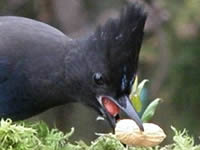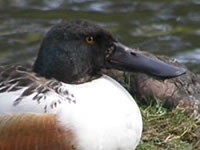The beaks, or more correctly, the bills of birds are cleverly adapted to securing the food they prefer. Here's a quick guide. Click on the images and a pop-up window will open with examples of birds in the group. |
| |
|
|
 |
__ |
The Crackers
Birds like finches, grosbeaks, cardinals and sparrows have cone-shaped bills used to crack open seeds. |
| |
|
|
 |
|
The Pickers
Insect eaters like wrens and warblers have tweezer-like bills which are thin and pointed and useful in picking insects off twigs and leaves. |
| |
|
|
 |
|
The Probers
Hummingbirds have long thin bills used like a straw with which they probe flowers to get nectar. |
| |
|
|
 |
|
The Chislers
Woodpeckers and their relatives have strong beaks with a tip used for pecking or drilling holes into wood in their search for grubs and insects underneath the bark. |
| |
|
|
 |
|
The Handy Ones
Ravens and crows have multi-purpose bills used for eating seeds, fruit, insects and other food. |
| |
|
|
 |
|
The Rippers
Eagles, hawks, owls and other birds of prey have sharp bills with hooks used to rip the flesh of prey. |
| |
|
|
 |
|
The Diggers
Some shore birds like the Black Oystercatcher have long, slender and sometimes curved beaks used for digging into the sand and mud in search of food. |
| |
|
|
 |
|
The Stabbers
Herons and kingfishers have spear-like bills used to stab at or grab fish and other prey. |
| |
|
|
 |
|
The Fishers
Some ducks like the Merganser eat fish and have tooth-like structures around the bill to hold their catch while draining water. |
| |
|
|
 |
|
The Sieves
Birds like Shovelers and Mallards have fringed, flat bills to strain seeds, grubs and plants from water. |
| |
|
|
.jpg) |
|
The Catchers
Birds which catch insects in flight usually have flat, wide bills. Many also have hairs at the base of their bills which are effective in capturing insects. |
| |
|
|












.jpg)
